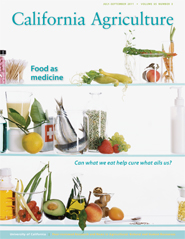All Issues

Food as medicine: Can what we eat help cure what ails us?
Cover:
Biofactors in foods — such as isoflavones in soy, omega-3 fatty acids in fish, antioxidants in produce and hydroxytyrosol in olive oil — may play a critical role in reducing the risk and symptoms of chronic illnesses such as heart disease, diabetes and kidney disease. Photo: Rita Maas, Getty Images
July-September 2011
Volume 65, Number 3
Volume 65, Number 3





